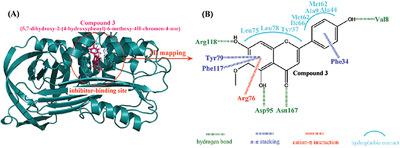当前位置:
X-MOL 学术
›
Biotechnol. Appl. Bioc.
›
论文详情
Our official English website, www.x-mol.net, welcomes your feedback! (Note: you will need to create a separate account there.)
Integrative identification of human serpin PAI-1 inhibitors from Dracaena dragon blood and molecular implications for inhibitor-induced PAI-1 allosterism
Biotechnology and Applied Biochemistry ( IF 2.8 ) Pub Date : 2021-01-12 , DOI: 10.1002/bab.2100 Chong Xu 1, 2 , Xia Liu 1, 2 , Jie Shen 1, 2 , Quan Sun 1, 2 , Xiaohong Guo 1, 2 , Min Yang 1, 2 , Jing Leng 1, 2
Biotechnology and Applied Biochemistry ( IF 2.8 ) Pub Date : 2021-01-12 , DOI: 10.1002/bab.2100 Chong Xu 1, 2 , Xia Liu 1, 2 , Jie Shen 1, 2 , Quan Sun 1, 2 , Xiaohong Guo 1, 2 , Min Yang 1, 2 , Jing Leng 1, 2
Affiliation

|
Human plasminogen activator inhibitor-1 (PAI-1) is an important component of the coagulation system and has been recognized as a potential therapeutic target of diverse cardiovascular disorders. Previously, it was found that the extracts from the Chinese medicine Dracaena dragon blood have potent inhibitory activity against PAI-1, but it is unclear which constituents directly participate in the inhibition and how do they regulate PAI-1 at molecular level. Here, we describe an integrated strategy to identify the dragon blood's chemical constituents that can directly target PAI-1. With the strategy, five compounds 1–5 are hit as promising PAI-1 inhibitor candidates, from which three are measured to have high or moderate activity against PAI-1. In particular, the compound 3 is determined to exhibit the highest potency; this value is roughly comparable with the widely used PAI-1 inhibitor Tiplaxtinin. We further examine the molecular effect of compound 3 on PAI-1 conformation at structural level. It is supposed that small-molecule inhibitor regulates the reactive center loop (RCL) of PAI-1 through an allosterism, that is, binding of compound 3 to PAI-1 can allosterically stabilize RCL in latent form, thus promoting PAI-1 conformational conversion from metastable active form to the inactive latent form. Long-term atomistic simulations also demonstrate that removal of compound 3 can destabilize the structured β-stranded conformation of RCL in latent form, although the current simulations are still not sufficient to characterize the full conversion dynamics trajectory.
中文翻译:

龙血树血中人丝氨酸蛋白酶抑制剂 PAI-1 抑制剂的综合鉴定及其对抑制剂诱导的 PAI-1 变构的分子意义
人纤溶酶原激活物抑制剂-1 (PAI-1) 是凝血系统的重要组成部分,已被公认为多种心血管疾病的潜在治疗靶点。此前,人们发现中药龙血树的提取物龙血对PAI-1具有强效抑制活性,但尚不清楚哪些成分直接参与抑制以及它们如何在分子水平上调节PAI-1。在这里,我们描述了一种综合策略来识别可以直接针对 PAI-1 的龙血化学成分。通过该策略,五种化合物 1-5 被认为是有希望的 PAI-1 抑制剂候选物,其中三种被测量为对 PAI-1 具有高或中等活性。特别是,化合物 3 被确定为表现出最高的效力;该值与广泛使用的 PAI-1 抑制剂 Tiplaxtinin 大致相当。我们进一步研究了化合物 3 在结构水平上对 PAI-1 构象的分子效应。假设小分子抑制剂通过变构调节 PAI-1 的反应中心环 (RCL),也就是说,化合物 3 与 PAI-1 的结合可以变构稳定潜伏形式的 RCL,从而促进 PAI-1 构象从亚稳态活性形式转变为非活性潜伏形式。长期原子模拟还表明,去除化合物 3 会破坏潜在形式的 RCL 的结构化 β 链构象,尽管目前的模拟仍不足以表征完整的转化动力学轨迹。
更新日期:2021-01-12
中文翻译:

龙血树血中人丝氨酸蛋白酶抑制剂 PAI-1 抑制剂的综合鉴定及其对抑制剂诱导的 PAI-1 变构的分子意义
人纤溶酶原激活物抑制剂-1 (PAI-1) 是凝血系统的重要组成部分,已被公认为多种心血管疾病的潜在治疗靶点。此前,人们发现中药龙血树的提取物龙血对PAI-1具有强效抑制活性,但尚不清楚哪些成分直接参与抑制以及它们如何在分子水平上调节PAI-1。在这里,我们描述了一种综合策略来识别可以直接针对 PAI-1 的龙血化学成分。通过该策略,五种化合物 1-5 被认为是有希望的 PAI-1 抑制剂候选物,其中三种被测量为对 PAI-1 具有高或中等活性。特别是,化合物 3 被确定为表现出最高的效力;该值与广泛使用的 PAI-1 抑制剂 Tiplaxtinin 大致相当。我们进一步研究了化合物 3 在结构水平上对 PAI-1 构象的分子效应。假设小分子抑制剂通过变构调节 PAI-1 的反应中心环 (RCL),也就是说,化合物 3 与 PAI-1 的结合可以变构稳定潜伏形式的 RCL,从而促进 PAI-1 构象从亚稳态活性形式转变为非活性潜伏形式。长期原子模拟还表明,去除化合物 3 会破坏潜在形式的 RCL 的结构化 β 链构象,尽管目前的模拟仍不足以表征完整的转化动力学轨迹。



























 京公网安备 11010802027423号
京公网安备 11010802027423号